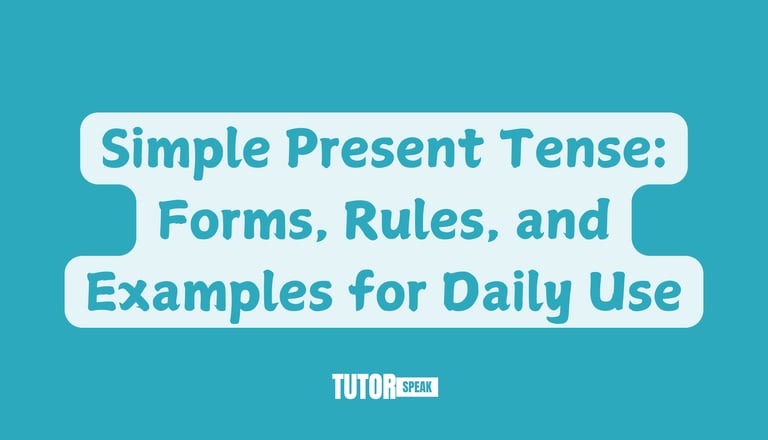Simple Present Tense: Forms, Rules, and Examples for Daily Use
Learn how to use the simple present tense in English with clear rules, examples, and explanations. Discover when to use the present simple tense in everyday communication.
TutorSpeak
2 min read


Simple Present Tense: Forms, Rules, and Examples for Daily Use
Learn how to use the simple present tense in English with clear rules, forms, and examples. Visit TutorSpeak to explore all English tenses explained simply.
1. What Is the Simple Present Tense?
The simple present tense (also called the present simple tense) is one of the most frequently used verb forms in English. It helps us describe habits, facts, general truths, and regular actions.
Examples:
I wake up early every morning.
The sun rises in the east.
She teaches English online.
We use it when something happens regularly, always, or generally.
2. How to Form the Simple Present Tense
✅ For most verbs:
I / You / We / They + base verb → play, read, work
He / She / It + base verb + -s or -es → plays, reads, works
Examples:
I study English every day.
He studies at the university.
They watch TV at night.
Spelling rules:
Add -es for verbs ending in -ch, -sh, -s, -x, -o: watches, washes, goes
Change y → ies after consonants: study → studies, try → tries
3. When to Use the Simple Present Tense
We use the simple present tense in different situations:
Habits or routines: She goes to the gym every day.
Permanent situations: He lives in Morocco.
General truths or facts: Water boils at 100°C.
Scheduled future events: The train leaves at 6 p.m. tomorrow.
Feelings or states: I like this song. She knows the answer.
To explore examples of all English tenses, check out TutorSpeak’s English Tenses Guide.
4. Common Mistakes to Avoid
❌ He go to school every day.
✅ He goes to school every day.
❌ She don’t like coffee.
✅ She doesn’t like coffee.
Remember:
Use “doesn’t” for he, she, it.
Use “don’t” for I, you, we, they.
5. Quick Practice Examples
Try filling in the blanks:
My brother ___ (play) football on weekends.
The store ___ (open) at 9 a.m.
I ___ (not/watch) TV in the morning.
She ___ (study) French at university.
Answers: plays – opens – don’t watch – studies
6. Summary
The simple present tense is essential for expressing daily routines, facts, and permanent situations. Once you master it, you’ll speak and write about your daily life with confidence and clarity.
Learn more about English tenses and how to master them step by step at TutorSpeak.



